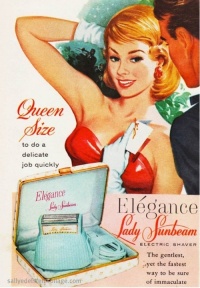Hair removal for aesthetic enhancement of women’s bodies has a long history.
The human body contains 5,000,000 hair follicles and while body hair seems pretty useless it actually serves a purpose. Hair helps regulate body temperature, keeping humans warmer in colder climates. It also helps protect the body from outside elements like dirt. Body hair is natural and helpful, why then do women spend so much time removing hair from their own bodies?
All in the name of beauty, of course.
The practice of removing female body hair is not new, it can be traced back to ancient Rome and Egypt.
Some of the first razors, made of copper, were used in Egypt and India around 3000 BCE. Egyptian women removed their head hair and considered pubic hair uncivilized. Upper-class Roman women of the sixth century BCE used tweezers, pumice stones and depilatories to achieve the desired degree of hairlessness, while Egyptians of Cleopatra’s time used a sugar mixture in a method similar to waxing. Elizabethan women removed their eyebrows and hair from their foreheads to give themselves a longer brow.
The modern era of hair removal may have been encouraged by Charles Darwin’s 1871 book, Descent of Man, through the popularization of his theories of natural selection. That is, homo sapiens have less body hair than his/her antecedents because less hairy mates were more sexually attractive. Body hair became a question of competitive selection. By the early 1900s, upper- and middle class white American women associated smooth skin with a desirable femininity.
Hair removal was encouraged through the efforts of three different industries: the women’s fashion industry, the men’s hair removal industry, and the women’s magazine industry, each of which recognized and sought to profit from women’s new role as consumers. First, hemlines rose, threatening to reveal hairy legs. Then, sleeveless garments bared arms. Exposed limbs in the changing fashions of the early 1900s pressured women to shave armpits and legs.
 Harper’s Bazaar was the first of the women’s magazines to run hair removal advertisements in a campaign that debuted in 1914. As arms and legs became more exposed, Gillette created the Milady Décolleté, which launched an anti-underarm hair campaign in 1915. With the first safety razor specifically for women available, Gillette ads urged them to remove “unsightly” and “objectionable hair” from their bodies, especially their underarms. In an ad that appeared in Harper’s Bazaar in 1915, completely bare underarms were a “necessity” to show off completely bare arms.
Harper’s Bazaar was the first of the women’s magazines to run hair removal advertisements in a campaign that debuted in 1914. As arms and legs became more exposed, Gillette created the Milady Décolleté, which launched an anti-underarm hair campaign in 1915. With the first safety razor specifically for women available, Gillette ads urged them to remove “unsightly” and “objectionable hair” from their bodies, especially their underarms. In an ad that appeared in Harper’s Bazaar in 1915, completely bare underarms were a “necessity” to show off completely bare arms.
Fashions of the 1940s, coupled with World War II meant that American women were more and more likely to shave their legs. The wartime shortage of nylon meant women couldn’t wear stockings every day. Having to go bare legged, more women shaved their legs, a practice that prepared them for the mini-skirt in the 1960s. By 1964, 98 percent of American women were routinely shaving their legs.
With the introduction of the bikini in 1946, the stage was set for women to start trimming pubic hair as well. In the 1950s, Hugh Hefner’s Playboy magazine introduced clean-shaven, scantily-clad model—sexy, lingerie-draped women who became benchmarks for the ideal look.
 Although Playboy flaunted its feminine beauties, feminists of the 1960s and 1970s turned their backs on the ideal of the hairless body in favor of women au natural. The rejection proved to be short-lived, however. Brazilian wax hit the mainstream. The first salon offering a complete wax hair removal experience came stateside in 1987. News of the practice travelled mostly through word of mouth. Hairless was back in. In a scene in Sex and the City around 2000, even Carrie Bradshaw gets one. Cleopatra would have approved.
Although Playboy flaunted its feminine beauties, feminists of the 1960s and 1970s turned their backs on the ideal of the hairless body in favor of women au natural. The rejection proved to be short-lived, however. Brazilian wax hit the mainstream. The first salon offering a complete wax hair removal experience came stateside in 1987. News of the practice travelled mostly through word of mouth. Hairless was back in. In a scene in Sex and the City around 2000, even Carrie Bradshaw gets one. Cleopatra would have approved.
Explore the history of extreme beauty trends with the current exhibit at the Women’s Museum of California, Beauty or Torture

